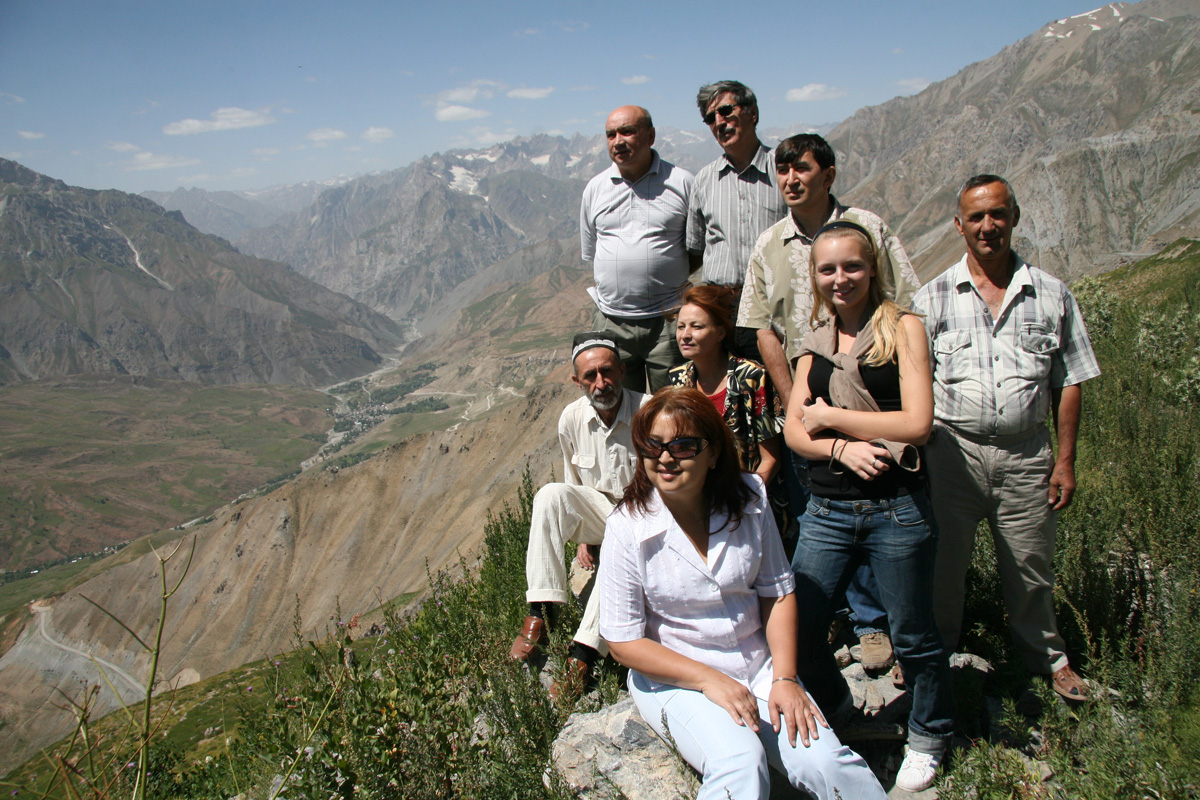
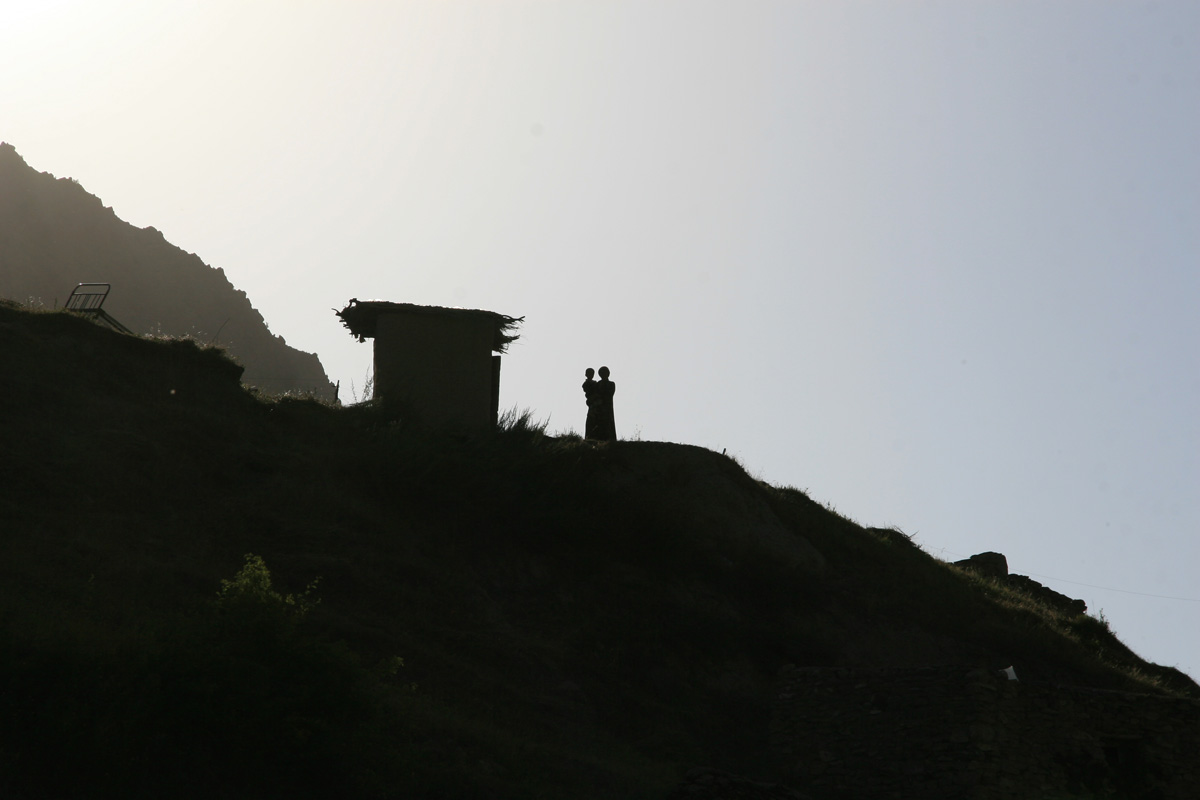

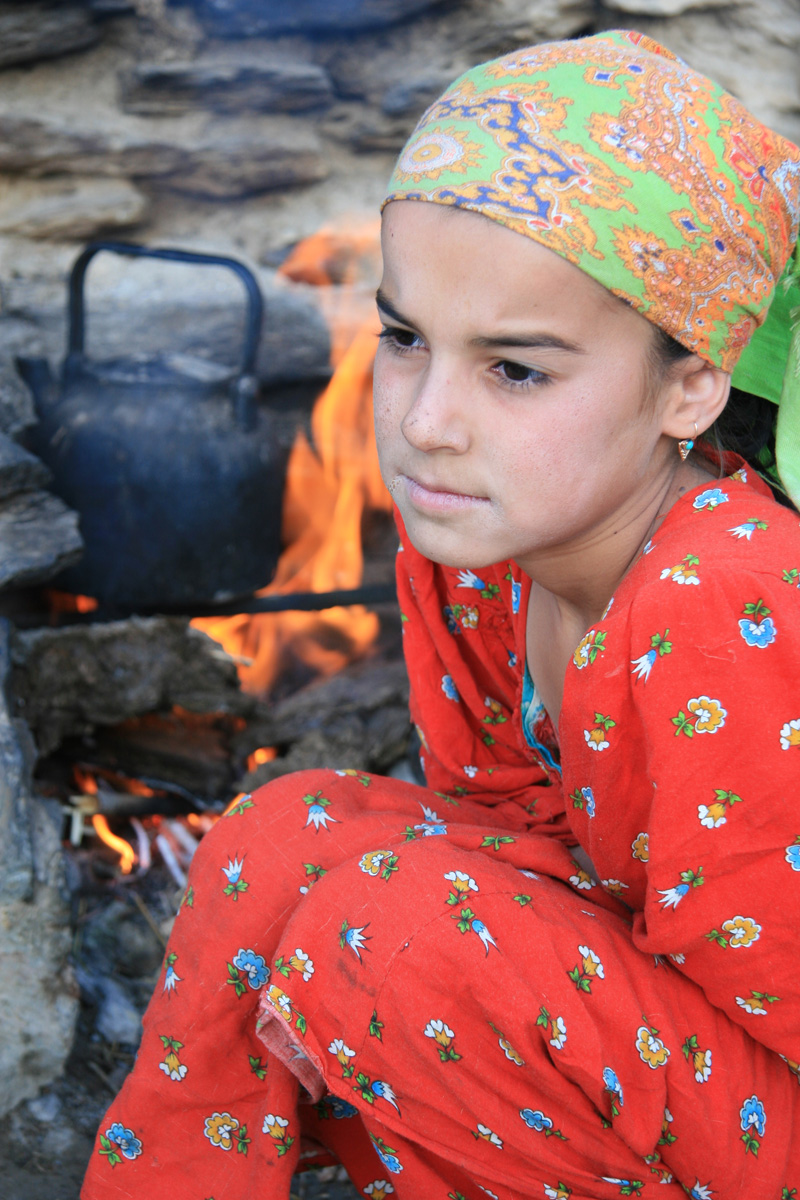
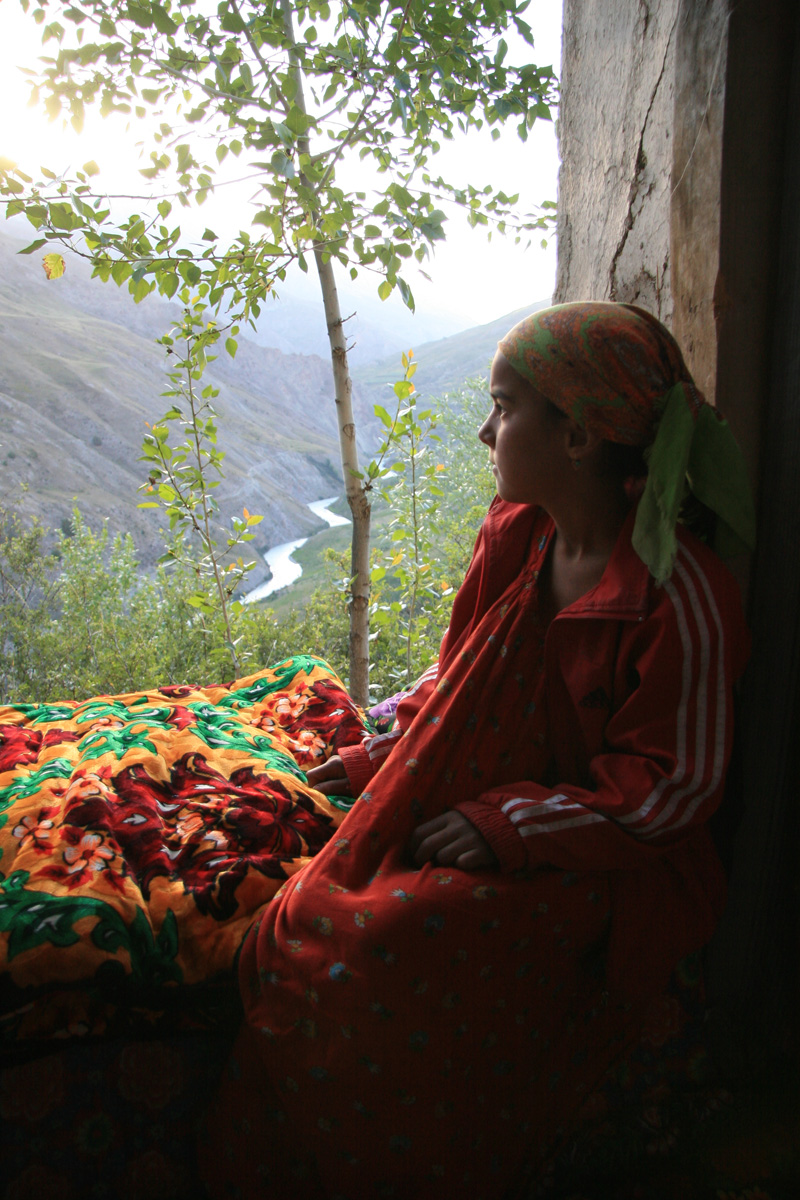
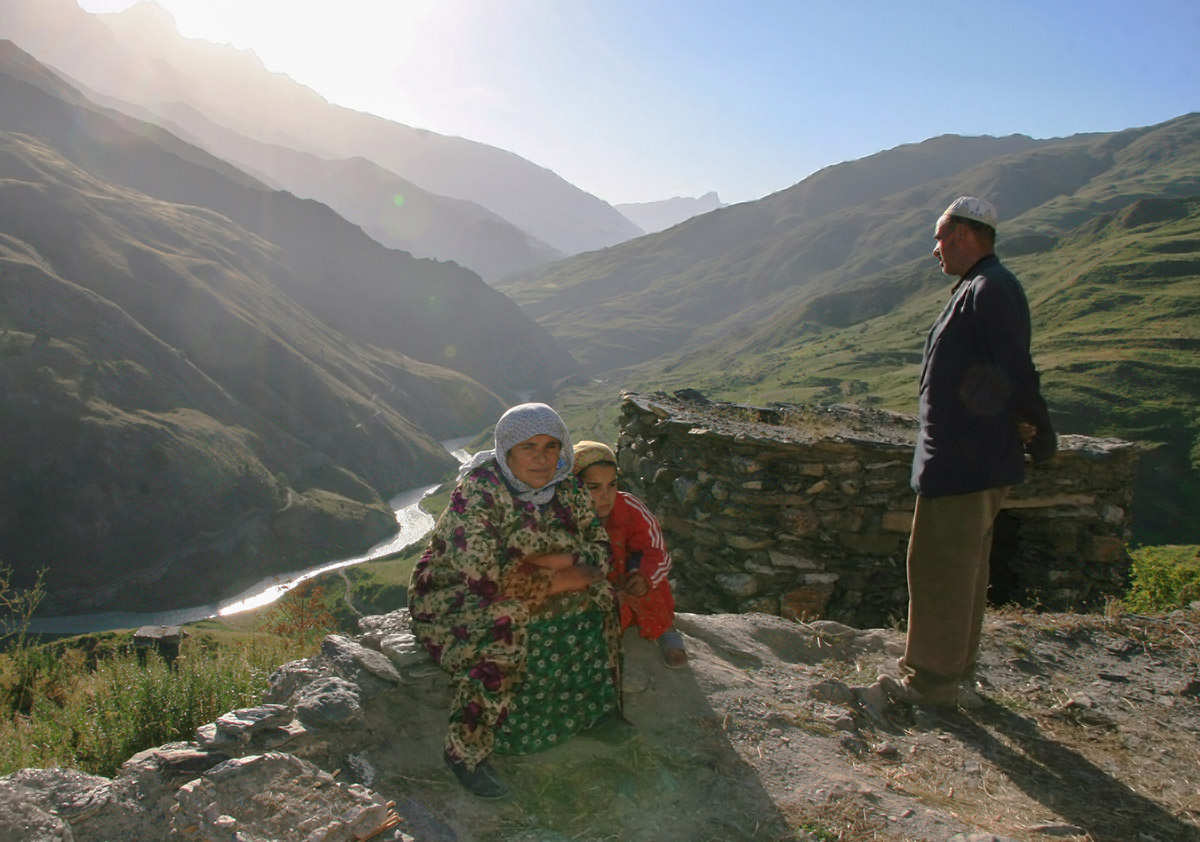
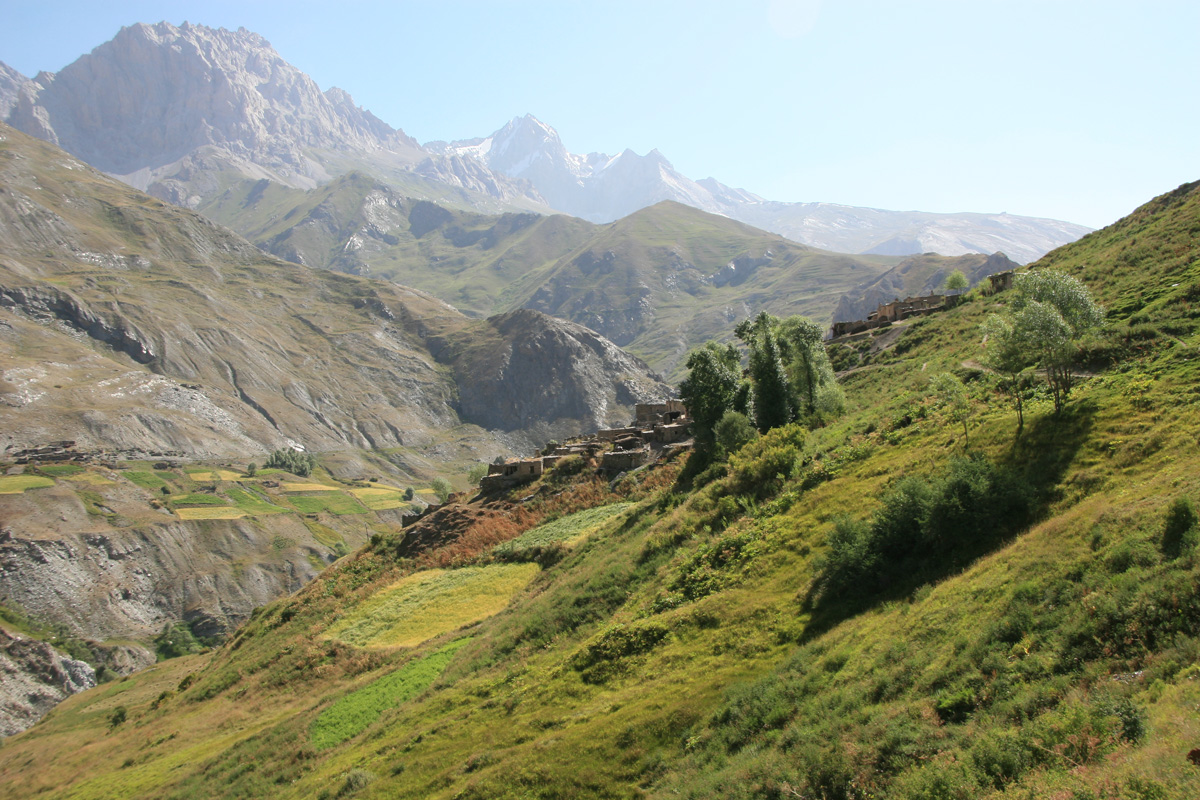
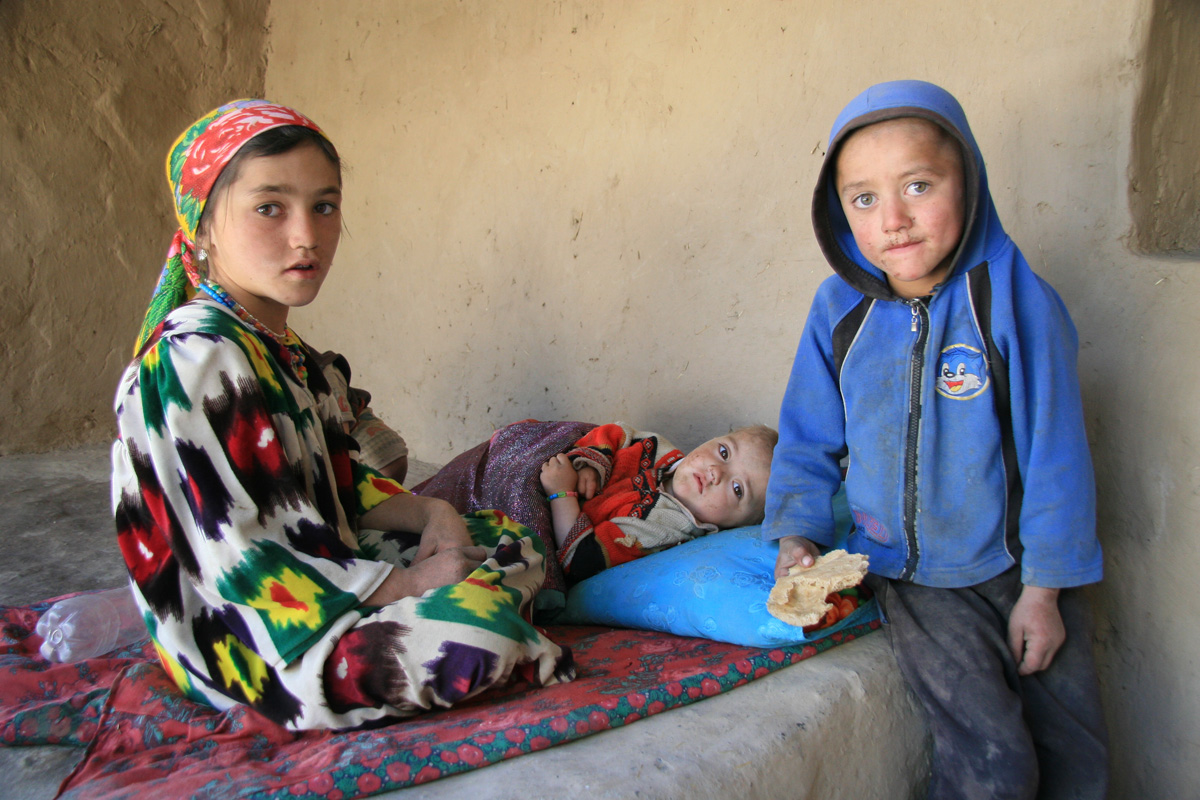
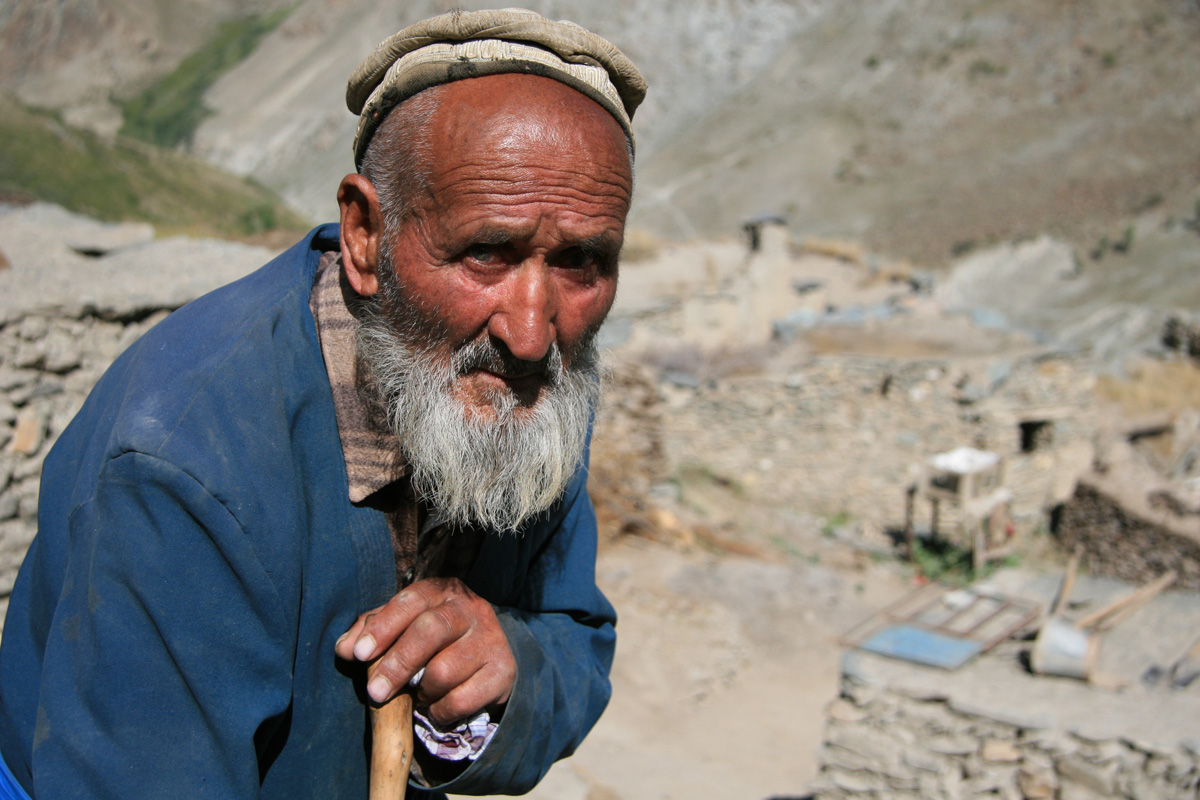
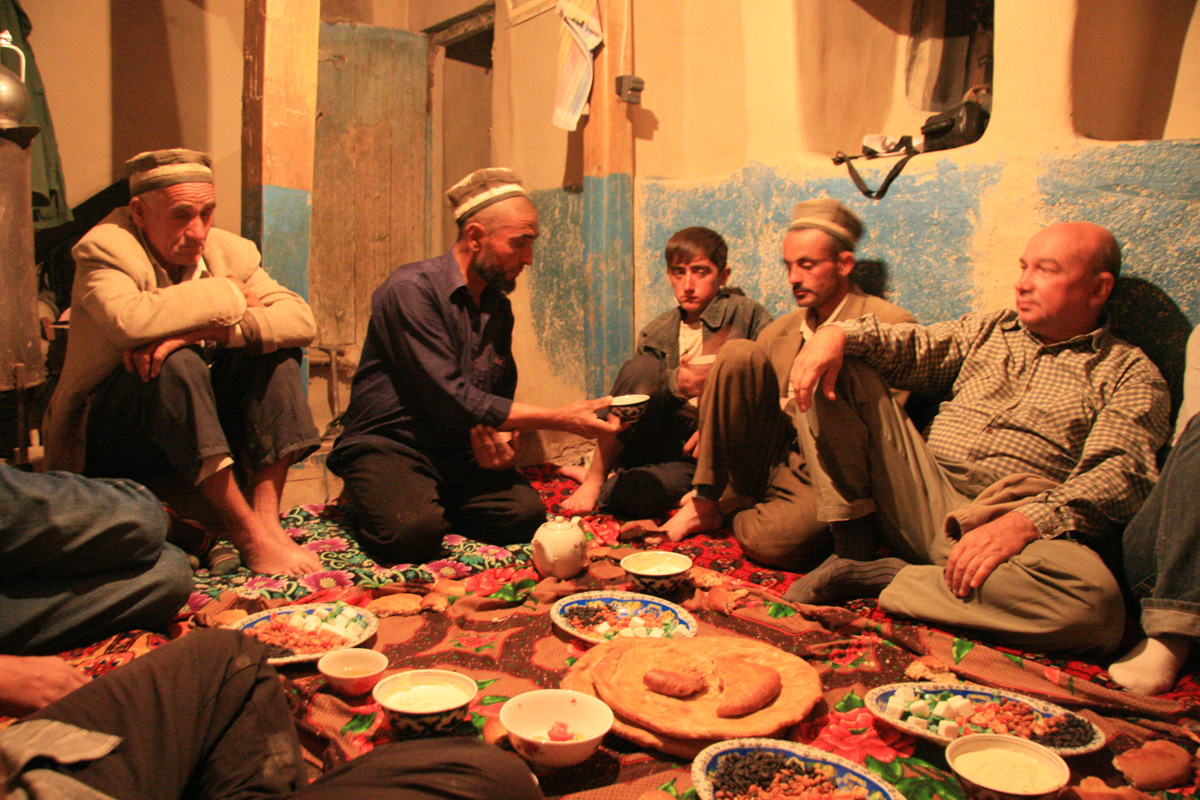
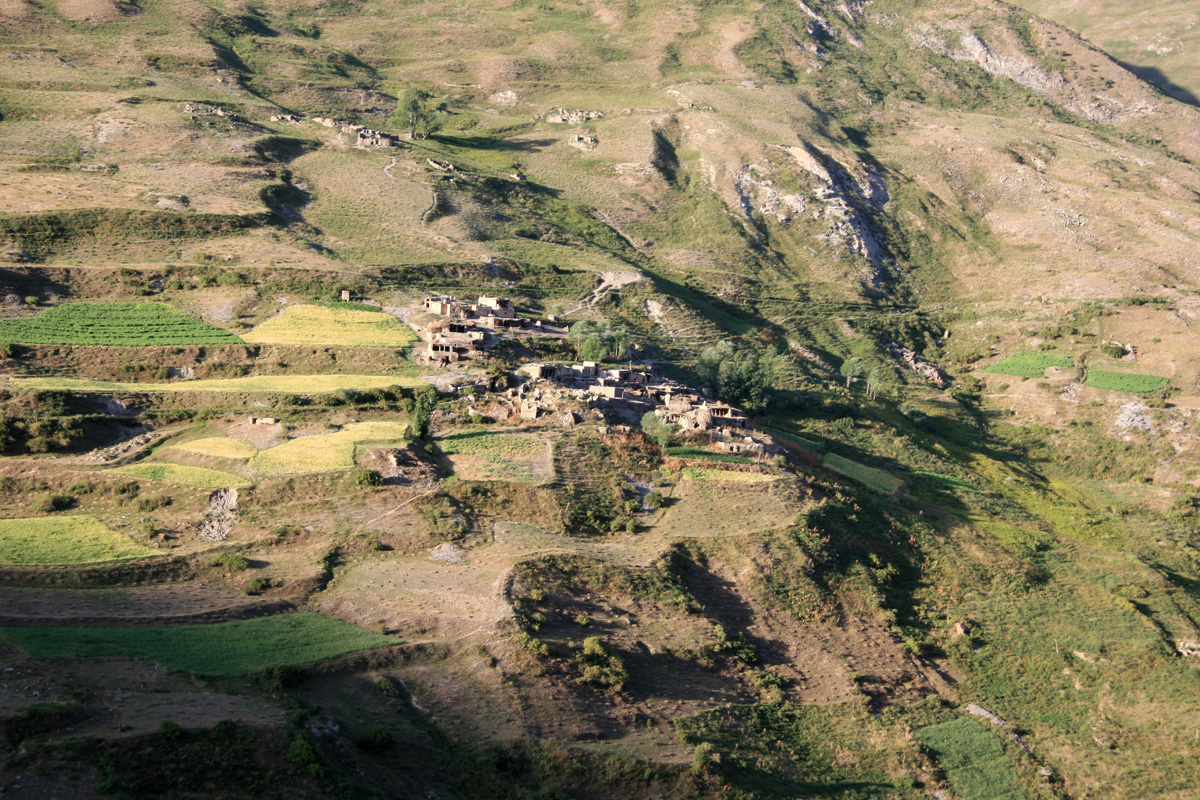
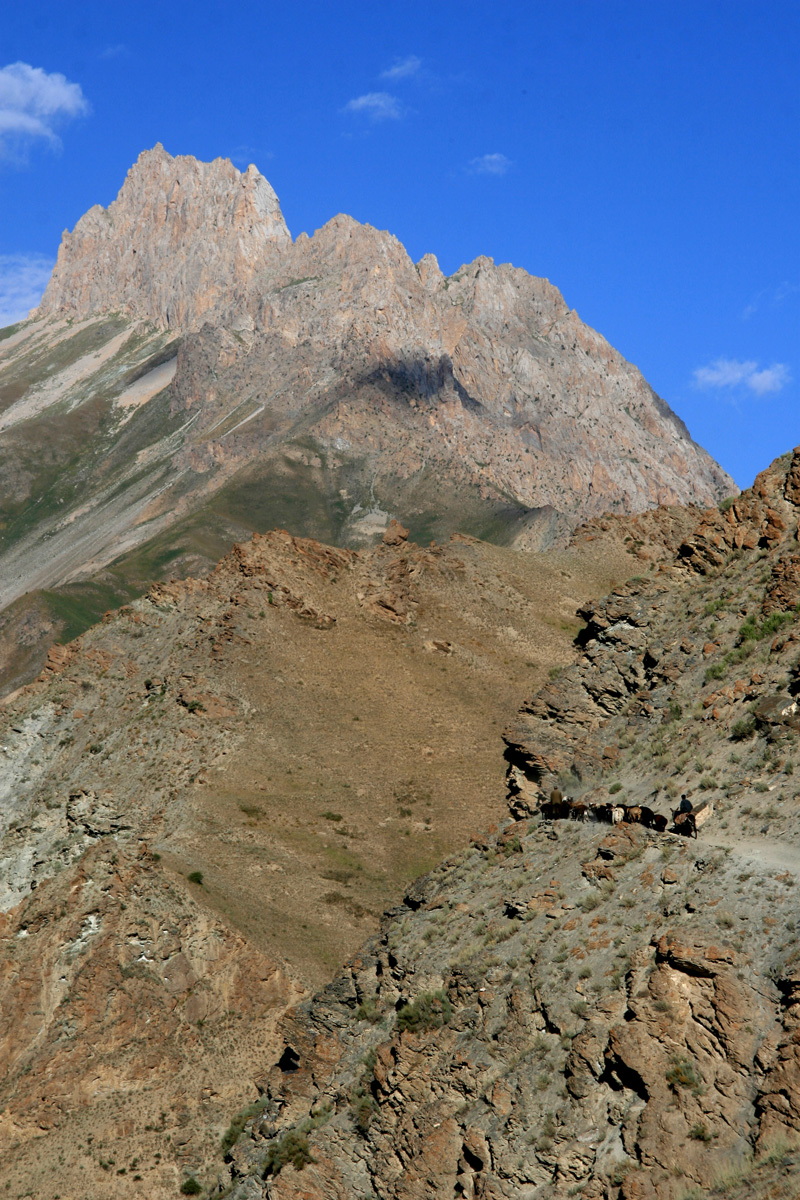
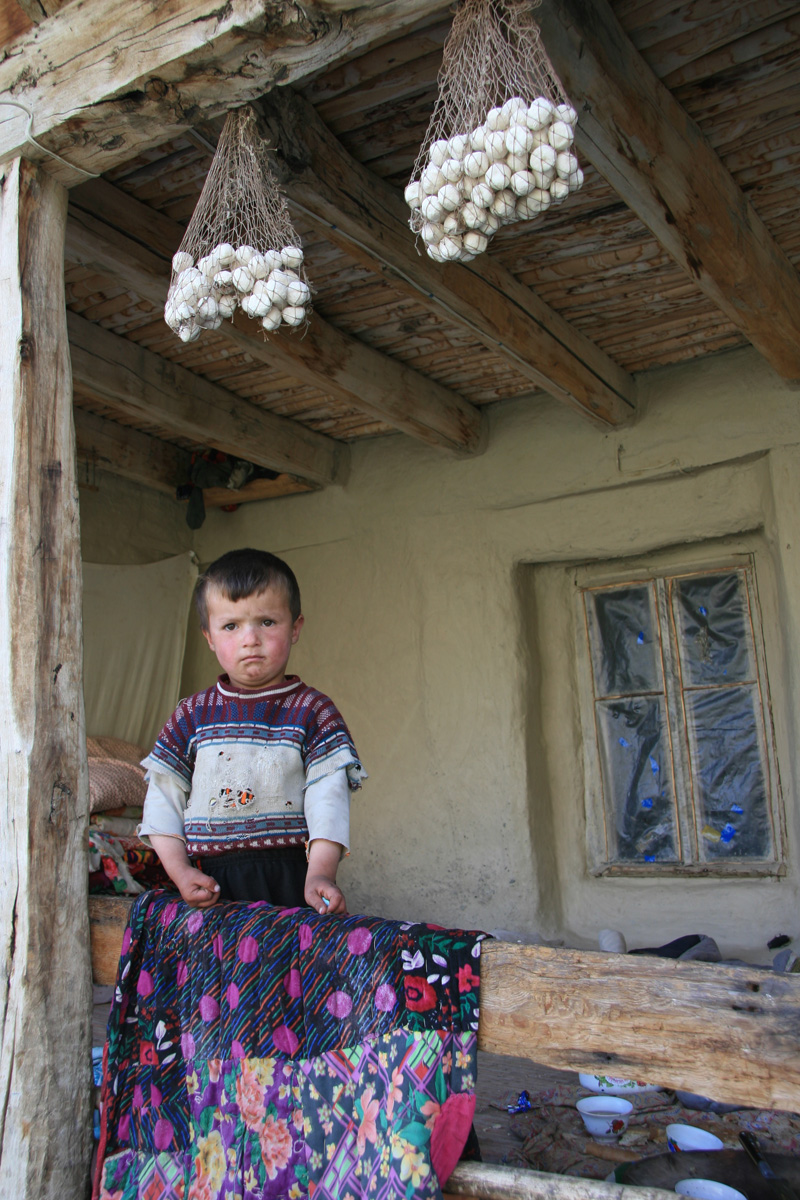
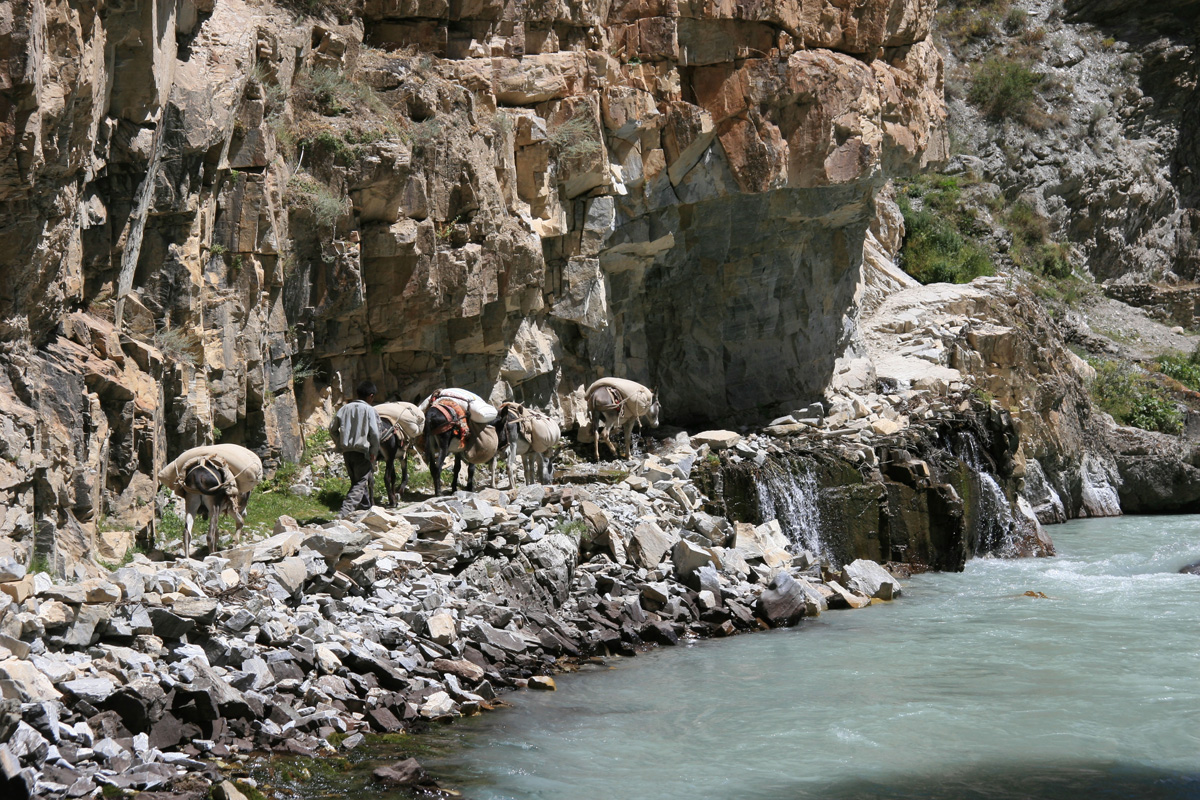
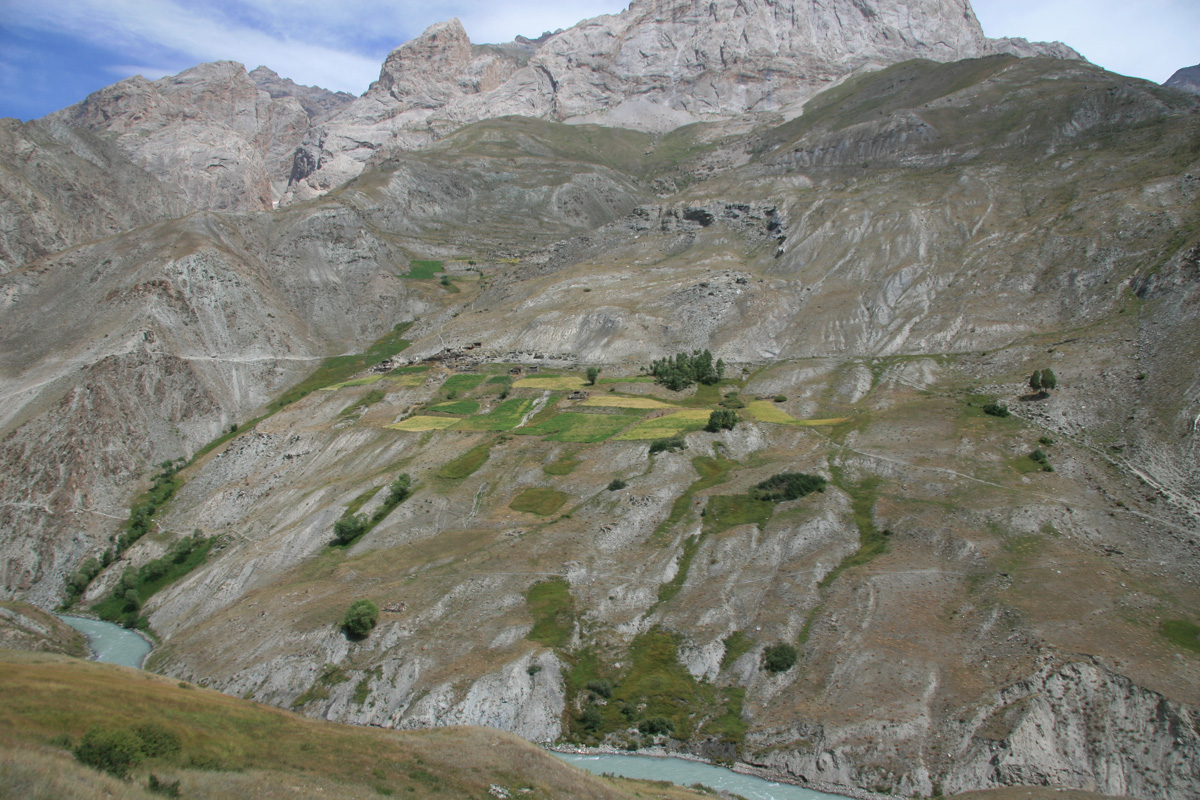
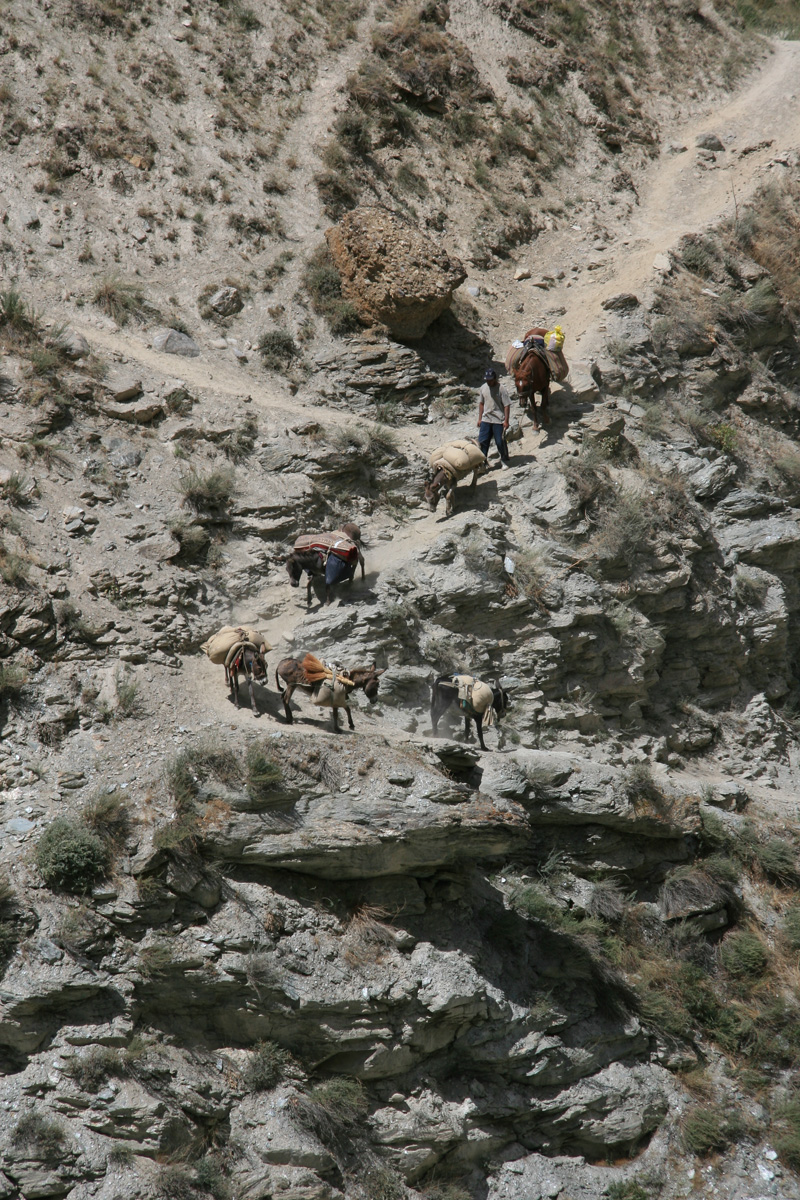
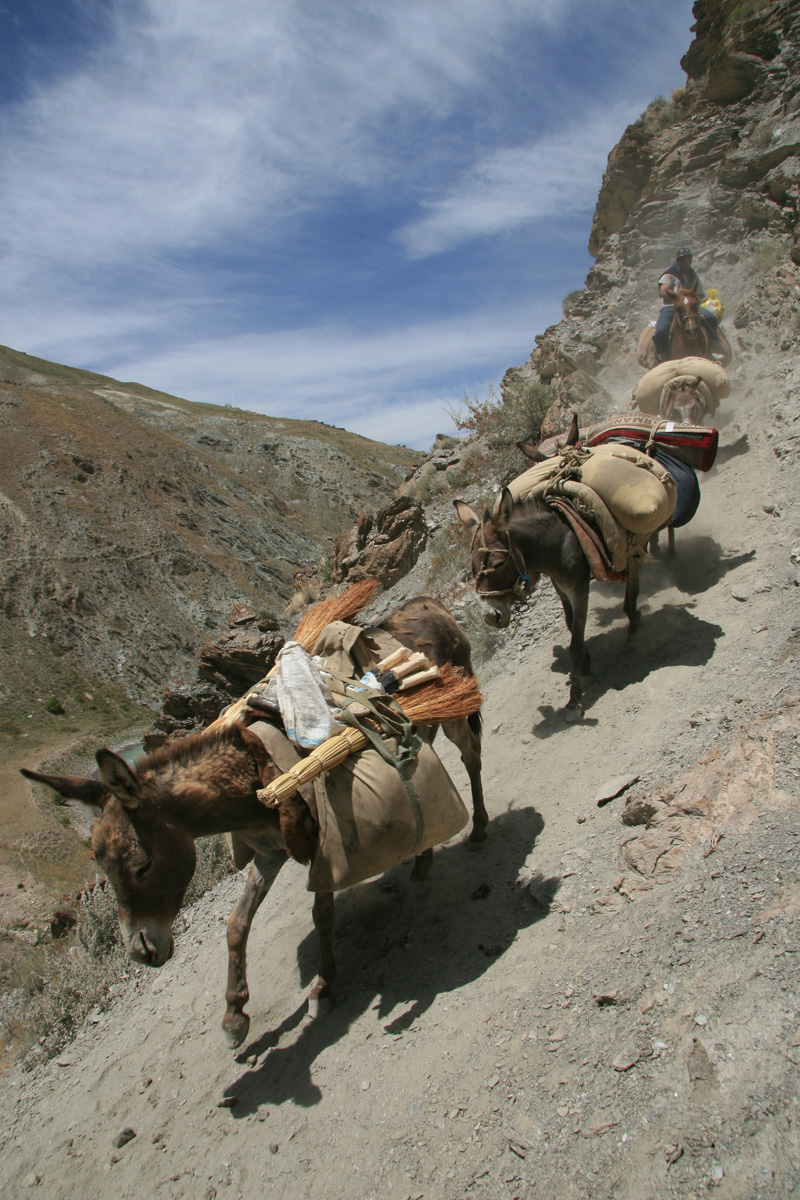
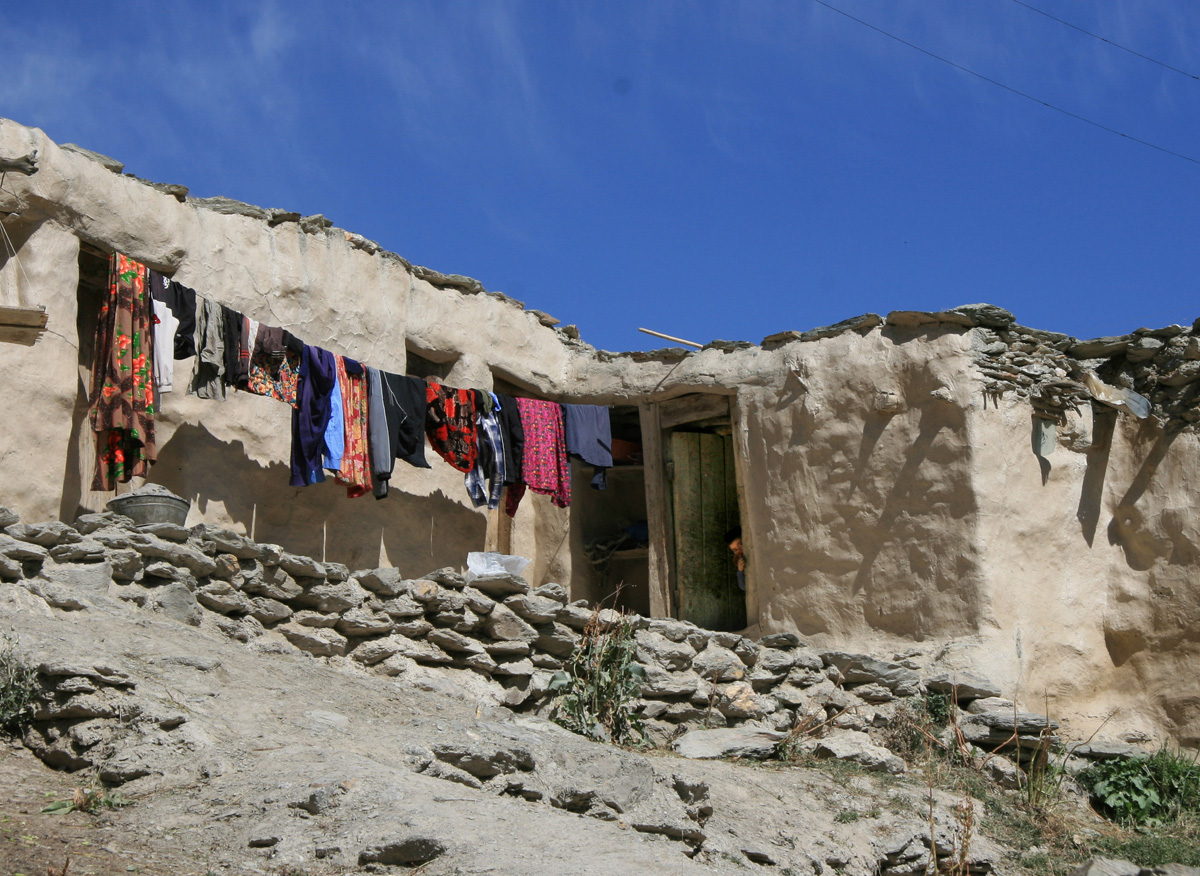

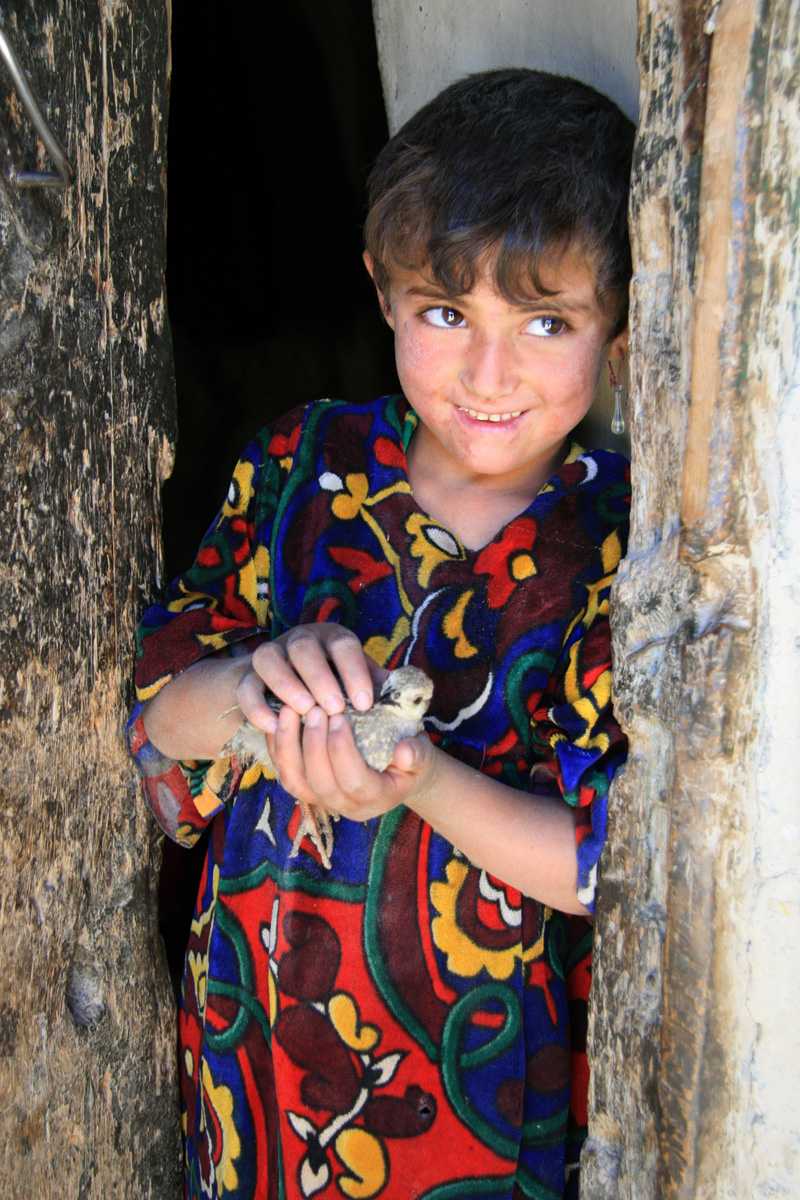
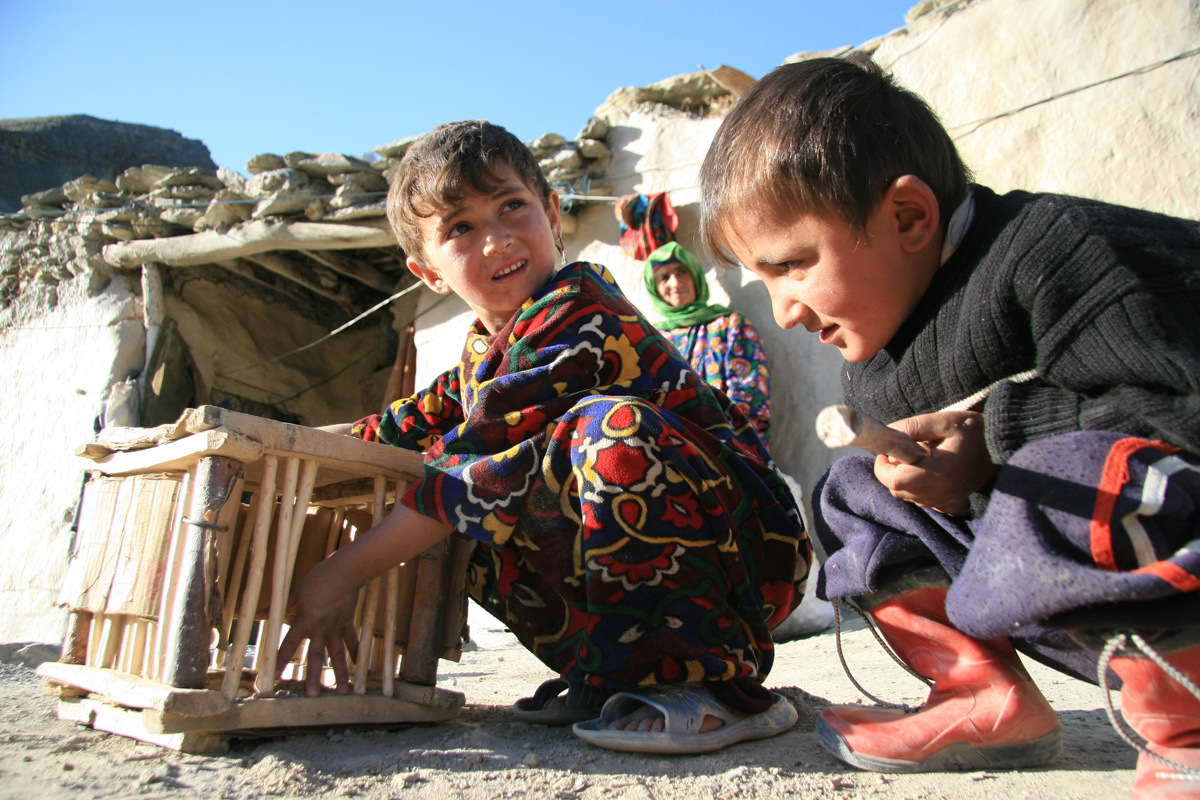
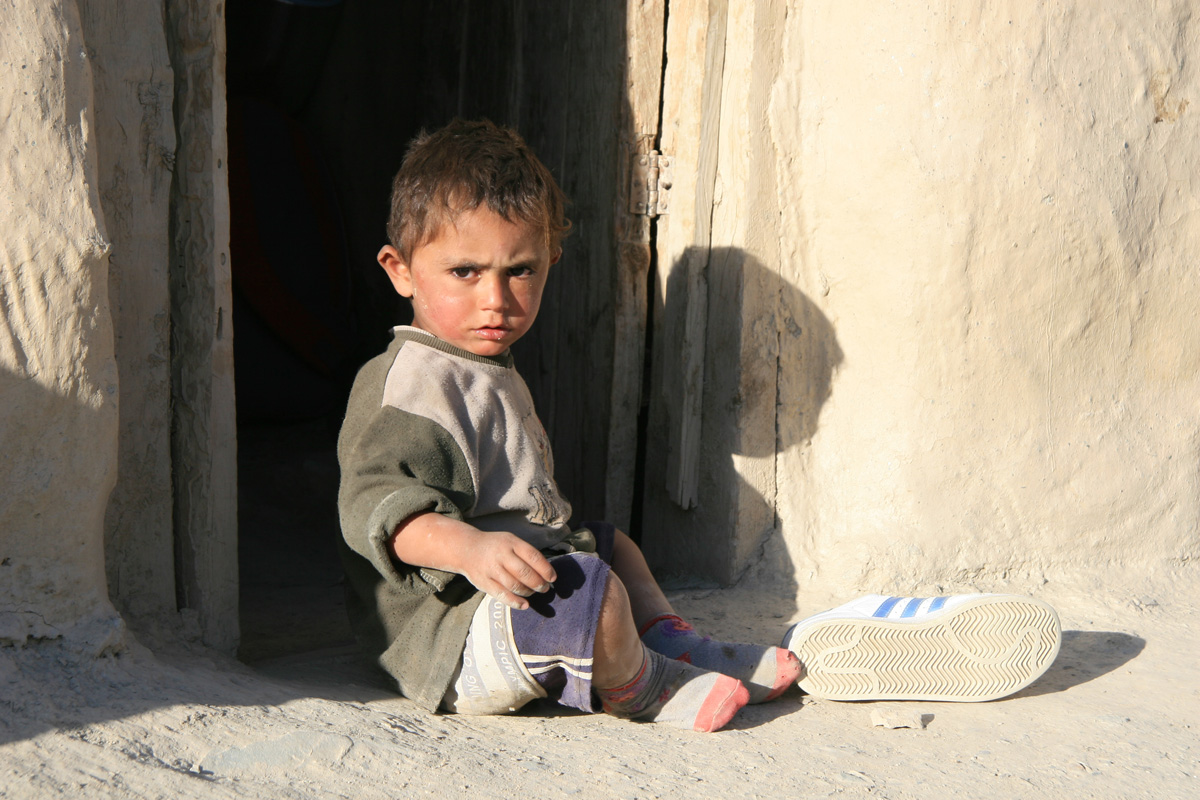
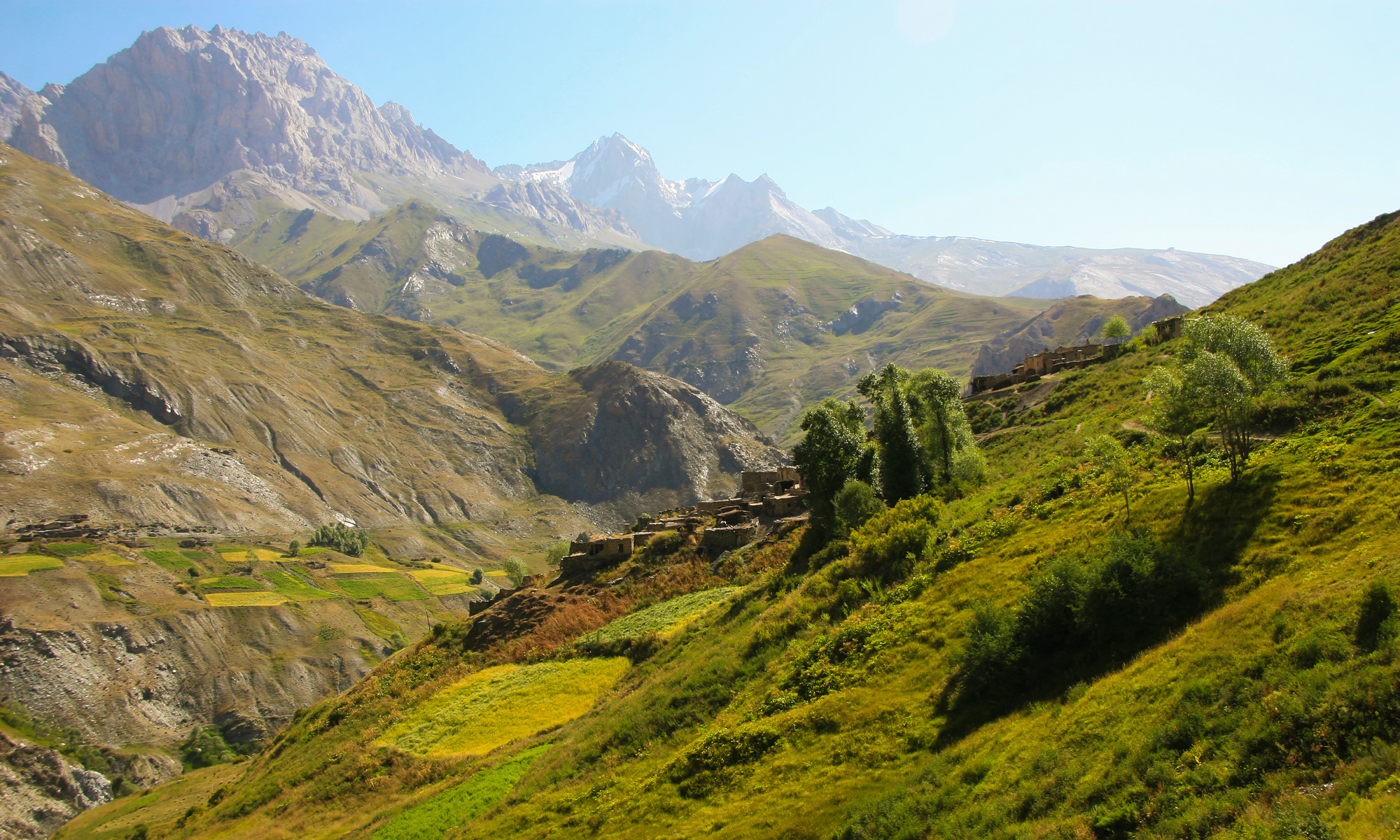
A Voice from the Mountains: Reviving Yaghnob’s Language, Life & Land
The Yaghnob Valley: Protect the Past, Shape the Future






















“We didn’t understand what they were saying — just that we had to go. Since I moved to Zafarobod, I have lost nine children. Can you imagine? Nine.”
— Bokiev, peasant, born 1930
The morning the helicopters came, Bokiev was feeding his sheep. The air in the Yaghnob Valley had always been quiet — thick with wind and memory. But on that day in 1970, it shattered with the whir of blades and the sound of boots.
He was 39, living on ancestral land, speaking Yaghnobi, farming barley and keeping stories alive. But the men who came down from the helicopters didn’t want stories. They came with orders.
“They said the valley was dangerous. Avalanches. Isolation. But we’d lived with those dangers for centuries. What we didn’t survive was the flatland.”
Along with 500 other families, Bokiev and his children were forcibly relocated to the cotton-growing district of **Zafarobod**. The government called it a “resettlement.” For the Yaghnobi people, it was a rupture.
“The water was poisoned. The ground was hot. We buried someone every day in the first weeks. My son died from the canal water. My daughter died with a fever. Nine children. Gone.”
The homes they were promised didn’t exist. Electricity, sanitation, even basic healthcare — none of it came. The Yaghnobis, mountain people used to cool air and thin altitudes, were thrown into a climate that suffocated them.
“We were told life would be better. But it wasn’t life at all. It was forgetting.”
Years passed. Governments changed. The promises faded. But Bokiev never let go. In the 1990s, when the state stopped watching, he returned to Yaghnob — thin, weathered, and full of grief.
“There was nothing left of our old house. Just stones and soil. But when I stepped on it, I heard something — like the land knew I had come back.”
Now in his 90s, Bokiev lives in a rebuilt home in the valley. He doesn’t speak often of Zafarobod, but when he does, it’s with a quiet fire — a reminder of the cost of forced forgetting.
“They took us with helicopters. But they couldn’t take Yaghnob out of us.”
When Culture Becomes Survival
Across the globe, heritage is woven into the fabric of everyday existence, expressed through lullabies, festivals, prayers, and crafts. These are not static artifacts but vibrant, evolving practices that are both delicate and robust. Today, numerous governments, organizations, and communities are developing innovative approaches to preserve intangible heritage. These initiatives offer valuable insights, highlighting the intricate interplay between history, social disparities, and cultural identity, benefiting not only those who uphold ancient traditions but society at large. Many of these traditions originate from communities that have endured prolonged periods of marginalization, including colonialism, forced displacement, and poverty. The remnants of these traditions often embody a complex mix of hardship and beauty. Increasingly, the wisdom embedded in these communities—regarding memory, resilience, ecological understanding, and interconnectedness—is recognized as essential for the entire world.
More Than Culture: Heritage as Resistance and Survival
In many impoverished regions, preserving heritage transcends mere nostalgia, serving as a crucial element for dignity, survival, and self-determination. Consider capoeira, a martial art born from African resilience in Brazil. Once suppressed by colonial powers, it has transformed into a global symbol of cultural strength, now thriving in diverse settings. For its practitioners, many of whom still grapple with racial prejudice, capoeira is more than an art form; it’s a vital connection to history, a declaration of identity, and an anchor to their roots.
In Morocco, traditional storytelling, known as halqa, was once a vibrant part of marketplace culture, sharing wisdom, humor, and tales of defiance. Originating from working-class communities, this oral tradition faced a decline with the advent of television and urban sprawl. Today, community initiatives are revitalizing halqa, reconnecting younger generations with their heritage not just as entertainment, but as a philosophical practice.
Similarly, in India, the Ramleela folk reenactments of ancient epics are kept alive by ordinary villagers, farmers, and laborers, rather than professionals. These extensive performances weave together religion, education, and theater, sustained by communal effort and shared belief rather than external funding.
These instances underscore a fundamental truth: heritage is not solely about the past; it is a powerful means of asserting presence in a world that often seeks to render certain communities invisible.
Why Protection Efforts Must Address Inequality
Disadvantaged communities are frequently shut out of national stories, their customs labeled as “backward” or “unofficial.” When intangible heritage finally gains recognition, the resulting benefits—grants, tourism, academic interest—often bypass the generations who have kept the tradition alive. Consider West African griots, oral historians and musicians once held in high esteem, who now often grapple with poverty and displacement despite their art’s global acclaim. In Indonesia, the international prestige afforded to batik through UNESCO has not translated into better conditions for many traditional workers, who continue to face low wages and inadequate recognition, threatening to turn a community-driven craft into an exclusive export. The core lesson is clear: intangible heritage cannot be protected without a commitment to justice, which demands that recognition be accompanied by funding, education, and inclusion. Without these elements, efforts to protect heritage are merely acts of appropriation.
Community-Led Protection: What’s Working
Against considerable odds, many of these communities have spearheaded novel heritage preservation models. These strategies are predominantly grassroots, locally driven, and guided by elders, women, and cultural workers.
All these instances illustrate that superior heritage efforts do not aim to freeze the past; rather, they endeavor to provide living culture the vital space to breathe, transform, and lead.
The Yaghnobi Lens: Memory and Mountain Songs
The Yagnobi people of Tajikistan possess a linguistic gem, the last echo of the ancient Sogdian language, a testament to their unique heritage. Beyond language, their traditions encompass the melodies women sing to bees, the blessings uttered over crops, and the ancestral tales preserved by elders from before the Soviet era. The Yagnob Valley could certainly host its own Living Heritage School, an annual festival celebrating mountain crafts and narratives, and a community-led safeguarding committee, mirroring successful initiatives in the Philippines, Morocco, and Bolivia. The size of the community is less important than the conviction that their heritage possesses future value.
What the World Must Learn
The initiatives of minority groups—often undertaken with meager resources and in the face of substantial adversity—provide critical takeaways: Heritage must be community-driven, not dictated by distant bodies. Recognition needs to tackle inequality head-on, ensuring marginalized populations reap rewards. Preservation efforts should bolster both cultural dignity and economic viability. Stories, songs, and rituals are living knowledge, not just peculiar traditions. Most significantly, intangible heritage is an imperative human right, not a mere amenity.
Final Reflection: Listening is the First Step
As this series concludes, we revisit a core principle: the most potent traditions globally are seldom confined to textbooks. They are embodied in the way a grandmother prepares food, the custom of naming a child, or the blessing of a field. If we approach these traditions with a willingness to listen—not as mere onlookers, but as genuine partners—we may remember that our most significant stories are still unwritten.
A Different Kind of History
History is often envisioned through books, documents, and official records. However, an older, more intimate history exists, conveyed through spoken words, sung melodies, and whispered tales from one generation to the next. This history lives not in libraries, but in memory, forming the bedrock of folklore and oral tradition.
Folklore is more than just fairy tales or old sayings; it is the emotional and moral core of a community, embodying its identity, survival strategies, and shared beliefs. From lullabies and riddles to myths and seasonal rituals, oral traditions have preserved communities’ pasts and their unique ways of navigating the world.↵↵In an age of globalization that often promotes uniformity, these traditions serve as quiet acts of cultural resilience. When languages are threatened, it is often this form of heritage that vanishes most silently.
What Is Folklore, Really?
At its heart, folklore is the living archive of a people, encompassing everything passed down orally: stories, proverbs, songs, chants, jokes, superstitions, legends, recipes, and more. It also resides in rituals—the distinct ways families celebrate marriages, mourn deaths, or welcome spring. Unlike written histories, folklore is inherently participatory, shaped by the teller and adapted for each listener in the moment. This fluidity is its power, enabling it to change with the times while preserving its essential spirit.
More than just entertainment, folklore serves to explain the world by offering origin stories, encoding rules for living, and acting as collective memory for unwritten knowledge. In many Indigenous and minority communities, folklore is the primary educational tool, educating not just children but entire generations.
Stories That Shape a People: Global Perspectives
The impact of folklore is universal, not confined to a single culture. From the Arctic Circle to the Pacific Ocean, the oral transmission of culture has been pivotal in shaping individual and collective identities and in preserving knowledge that is at risk of disappearing.
In Sápmi, the indigenous Sámi people’s traditional lands in Norway, Sweden, and Finland, the unique vocal expression known as joik was once suppressed by assimilationist policies. However, joik endured in private homes and isolated villages, serving as a vehicle for conveying not only stories but also the essence of landscapes, emotions, and spiritual bonds. Today, it is being revitalized as a marker of cultural pride, integrated into school curricula and celebrated in public performances.
In Aotearoa, the Māori people have a long-standing tradition of transmitting values through whakataukī and mōteatea.
The Māori proverb “Ka mua, ka muri,” meaning “Walking backwards into the future,” encapsulates the belief that the past constantly guides our steps. Through Māori oral history, language and traditions have not only survived but have also been instrumental in restoring legal land rights in courts, as these narratives validate ancestral connections.
In the Basque Country, the art of bertsolaritza, characterized by competitive oral poetry, continues to be a deeply revered practice. These improvisational verses, presented to live audiences, artfully combine wit, political commentary, and remembrance. Despite historical persecution under the Franco regime, bertsolaritza has re-emerged as a symbol of cultural fortitude, actively taught to youth as a living tradition.
These diverse examples illustrate that oral tradition acts as a form of cultural subconscious, strengthening with each recitation, safeguarded by deep emotional connections, and passed down discreetly, like a shared secret. Folklore thrives because it holds profound meaning for the people.
What We Lose When Folklore Fades
When a language begins to fade, its grammar and vocabulary might be recorded by linguists, but folklore is far more challenging to capture. It relies on intonation, gesture, timing, and setting – elements that exist only in the moment of telling. Thus, as a community ceases to use its language, its stories also fall silent. The loss is not merely informational but also connective. Folklore contains vital ecological knowledge, such as optimal fishing times, how to interpret clouds, and which plants possess healing properties. It also preserves social ethics, detailing how to raise children, treat guests, and resolve disputes, alongside spiritual balance, including how to honor ancestors, mark seasonal shifts, or protect against misfortune. Without these traditions, younger generations may lose their sense of place and continuity, leaving communities more vulnerable to cultural fragmentation, even if their language technically survives. Furthermore, every oral tradition offers a unique perspective on the world; its fading means we all lose access to another way of understanding the human experience.
The Yaghnobi Example: Stories in the Shadow of Silence
The documents collected over the years—some of which have been shared in this project—contain fairy tales, farming proverbs, healing chants, and legends of exile. They speak of animals that talk, mountains that remember, and rivers that bless or punish. These are not just children’s stories. They teach how to read the land, how to work together, and how to maintain dignity even in displacement.
One tale tells of two brothers lost in the mountains, saved only when they remember a forgotten blessing from their grandmother. Another speaks of a woman who sings to bees to help her crops grow. Such stories contain moral codes, survival wisdom, and identity anchors.
Keeping the Stories Alive
Across the globe, communities are implementing strategies to preserve and share their folklore. These methods include recording elders’ narratives in their native tongues and in translation, educating children via story circles, festivals, and games, and creating bilingual publications and oral history archives. In Yaghnob, similar efforts are underway, with researchers, language activists, and local families beginning to document and translate stories for younger generations, though further progress hinges on time, financial support, and community trust.
Because in the end, every story kept alive is an act of cultural renewal.
In Every Language, a Universe
Folklore is not about dwelling on the past; it’s about living memory. Within every chant, proverb, and tale of talking animals or magical trees lies a people’s entire perspective on existence. The Yaghnobi narrative demonstrates that even the humblest communities harbor vast cultural riches. Their stories, though sometimes obscure, are as vital as any of the world’s great oral traditions. Ultimately, every tale, whether a Basque rhyme, a Māori chant, or a Yaghnobi whisper, carries a thread of universal truth.
A Hidden Map Beneath the Nations
Central Asia possesses an unseen map, distinct from political borders and capitals—a landscape etched in the stories, songs, and languages that echo through generations. Below the contemporary nations of Tajikistan, Uzbekistan, Kazakhstan, Kyrgyzstan, and Turkmenistan, a deeper reality thrives: a continent of cultural threads intricately woven into its mountains, deserts, and steppes, representing not mere historical artifacts but dynamic, resilient traditions. This region is a vibrant patchwork of peoples, including Turkic-speaking groups like the Uzbeks, Kazakhs, Kyrgyz, and Turkmens; Iranian-speaking minorities such as the Yaghnobis, Wakhi, and Pamiris; and other ethnicities such as the Bukharan Jews, Uighurs, and Dungans. Across this diverse terrain, from the high Pamirs to the windswept plains near the Aral Sea, numerous communities steadfastly maintain their unique languages, observe their ancestral ceremonies, and preserve their histories, often independent of official narratives, collectively creating a cultural richness that, though frequently unacknowledged in national discourse, is profoundly present in daily life.
Pamiris: Voices from the Roof of the World
In the formidable mountains of eastern Tajikistan, the Pamiri communities have tenaciously safeguarded their unique linguistic heritage and cultural practices, enduring centuries of separation. Their languages, such as Shughni, Wakhi, and Yazgulyami, bear a closer resemblance to ancient Avestan than to Tajik, the official language of their country. Despite past Soviet policies aimed at standardizing identity and language, many Pamiris have continued their vibrant traditions of poetry, storytelling, and festival celebrations in their mother tongues. Presently, Shughni-speaking poets are actively publishing, musicians are performing in local dialects, and Pamiri voices resonate through community radio and international diaspora channels. Though confronting challenges including urban migration, limited educational resources, and governmental neglect, the revival of cultural pride in these mountainous regions is distinctly palpable..
Karakalpaks: Culture, Television, and Tenacity
To the west, in the republic of Karakalpakstan, the Karakalpak people have established a distinct identity through their language, literature, and cultural institutions. Despite the environmental crisis caused by the Aral Sea’s desiccation and economic challenges, they sustain a regional university, a public television channel, and a literary tradition encompassing newspapers, poetry, and children’s books. While Uzbek gains prominence in urban centers, many Karakalpaks continue to use their native tongue at home, in educational settings, and in public life.
Wakhi: A Language Across Borders
In the border regions connecting Tajikistan, Afghanistan, Pakistan, and China, the Wakhi people maintain their language and a strong, cross-border sense of identity. Despite being dispersed across various states and policies, the Wakhi community remains tightly knit.
In northern Pakistan, non-governmental organizations have fostered Wakhi language education. Local leaders have developed educational materials, produced music, and organized language immersion programs. Wakhi elders transmit not only their language but also comprehensive knowledge systems concerning animal movements, medicinal plants, and spiritual practices, all intricately linked to the cyclical rhythm of the seasons. Their unifying bond is not political statehood, but rather shared narratives, collective memories, and their common language.
Uighurs and Other Minorities
Across Kazakhstan and Kyrgyzstan, Uighur communities actively maintain their cultural centers, publish newspapers, and provide education in their native language, navigating broader political complexities. In southern Kazakhstan, Tatar, Uzbek, and Dungan populations sustain multilingual educational and religious institutions. Even the Koryo-saram, ethnic Koreans displaced by Stalin in the 1930s, have revitalized their communities through bilingual education and media outreach.
What unifies these groups transcends mere cultural pride; it embodies a shared tenacity against shifting borders, centralized governance, and often unsupportive administrations. Despite their distinct challenges, their adaptive strategies reveal considerable ingenuity. Festivals and ceremonies, far from being mere entertainment, are vital for identity preservation. Crucial knowledge is transmitted through music, dance, and oral traditions, supplementing formal education.
What Cultural Survival Teaches Us
Unfortunately, these initiatives are not always sufficient. State language policies, financial deficits, and the exodus of economic migrants continue to weaken the transmission of languages from one generation to the next. In numerous households, the younger members converse exclusively in Russian or the dominant national language, consequently losing their ancestral tongue’s fluency. Some dialects—particularly those of smaller Pamiri or Turkic groups—are now spoken only by the elderly. Without prompt support and educational interventions, these languages face the imminent threat of silence.
Nevertheless, Central Asia’s diversity represents more than a cultural embellishment; it holds significant value. Many minority communities preserve intricate ecological knowledge of their specific environments—how to farm on steep mountain terraces, how to utilize native plants for medicinal purposes, and how to predict weather patterns through natural signs. Their languages embed spiritual philosophies, societal ethics, and environmental relationships that offer insights extending far beyond their immediate regions. In an era of global uncertainty, the continued existence of these worldviews may prove increasingly, rather than less, essential.
There is something quietly radical about choosing to speak a language your grandparents were once told to forget.
Across the globe, minority languages are fading, yet communities like the Yaghnobi people of Tajikistan persist in isolated valleys and through family traditions. Other groups, such as the Māori of New Zealand, the Sámi of Scandinavia, and the Basques of Spain and France, have moved from mere survival to active revitalization.
Their experiences offer both inspiration and valuable lessons. While history has attempted to erase the Yaghnobi language, these examples demonstrate that history can also pave the way for recovery.
The Māori: Nurturing the Language from the Cradle
During the 1980s, the Māori language was perceived by many in New Zealand to be in decline, with English dominating education and media, and younger generations not learning the ancestral tongue. In response, Māori communities initiated a significant cultural revival by establishing “language nests” (kōhanga reo). These were community-led preschools where fluent elders immersed young children in te reo Māori, replicating natural language acquisition through constant exposure and affection. This grassroots movement fostered a generation of Māori-speaking children who entered the school system, leading to the creation of Māori-language schools, media presence, and official recognition. Te reo Māori is now a prominent feature of public life, showcasing how community-driven initiatives by elders and children can revitalize a language.
The Sámi: Healing Through Language and Land
FIn the northern reaches of Norway, Sweden, and Finland, remote from Central Asia’s mountains, the Sámi people have spent decades painstakingly reconstructing what was nearly lost. For an extended period, Sámi children were subjected to boarding schools where speaking their language was met with punishment, and their cultural practices—encompassing reindeer herding, joik, and seasonal migrations—were derided as primitive. Like the Yaghnobis, they were perceived not as a living culture, but as a rural impediment. Nevertheless, in more recent times, a more understated transformation has taken root. Sámi communities have actively campaigned for and secured the right to converse in their languages within schools, access healthcare in their mother tongue, and preserve their traditional livelihoods. Sámi-language media, cultural centers, and dedicated language programs have proliferated, frequently propelled by grassroots community endeavors rather than solely by state directives. A particularly affecting illustration originates from Sweden, where a Sámi Language Center was established as a sanctuary not merely for language acquisition, but for profound healing. Ultimately, language loss exerts not only a linguistic toll but also an emotional one; reclaiming language serves to re-establish connections to the land, ancestors, and one’s core identity. Several Sámi dialects had come perilously close to extinction, yet elders partnered with linguists to devise new alphabets, compile dictionaries, and impart literacy in their ancestral tongue to the youth. This arduous yet crucial work has successfully reintroduced long-dormant languages to the public consciousness. For Yaghnobi speakers, many of whom still harbor memories of forced relocation and cultural disruption, the Sámi experience offers a precious testament: unequivocal proof that healing and revitalization can progress hand in hand.
The Basques: Making Language Public Again
In the northern reaches of Spain and southwestern France, the Basque people have accomplished something remarkable: they have brought a language that was long suppressed back into the core of public life.
During Spain’s Franco regime, the Basque language, known as Euskara, was prohibited in schools and discouraged in official capacities. While Basques continued to use it within their homes, public use carried risks, leading to generations of children who heard their native tongue but couldn’t read or write it.
This began to change following Spain’s democratic transition. Political autonomy enabled the Basque region to finance its own language schools, called euskaltegiak, which also served adults who had never had the opportunity to learn. Street signs started appearing in Euskara, media outlets began broadcasting in the language, and schools incorporated it into their curriculum. This led to a flourishing of Basque music, literature, and theater.
The success of the Basque revival hinges on its visibility. By featuring the language in public arenas—on buses, menus, and university lecture halls—they signaled to everyone, Basque or not, that the language holds significance and is not merely a private matter. It became something to be celebrated openly.
This approach offers a clear message: a language requires a platform. It must be visible, audible, and integrated into daily life. For the Yaghnobi, whose language is too often confined to private spheres, this could translate into new opportunities for village signage, community radio stations, cultural festivals, or even basic language classes for both adults and children.
Shared Threads, Shared Strength
These three stories, spanning continents and political systems, echo with shared truths. First, revitalization originates within the community, with the power residing in the people, whether through Māori language nests, Sámi storytelling circles, or Basque adult classrooms. Second, elders are indispensable, acting as guardians not only of vocabulary but of entire worldviews. As in Sámi and Māori cultures, they hold the songs, stories, and seasonal wisdom that imbue language with profound meaning. Third, visibility fuels vitality; a language relegated to the home becomes a private memory, whereas one displayed on signs, broadcast on the radio, or taught in schools transforms into a living presence. Fourth, and perhaps most critically, language loss is not an inescapable destiny; even the most fragile linguistic thread can be rewoven.
Returning to Yaghnob: What Is Possible
For the Yaghnobi people, whose language has navigated mountains, exile, and upheaval, these examples are profoundly relevant. Initiatives are already underway, including language documentation, dictionary creation, folklore studies, and efforts to return to their valley. The critical missing elements are the infrastructure—schools, cultural hubs, and the everyday presence—that empower a language to thrive. The revitalization successes in Aotearoa, Lapland, and the Basque Country demonstrate unequivocally that even languages pushed to the brink can be resurrected with community commitment and cultural self-respect.
In secluded valleys, words endure beyond screens, whispered between generations in lullabies, blessings, and traditions tied to the land. The Yaghnobi language, spoken in a valley in northern Tajikistan, has persisted through historical turmoil, yet its future remains precarious.
Linguists classify Yaghnobi as “endangered,” a term that fails to convey the profound loss incurred when a language’s unique vocabulary, tied to specific cultural contexts, fades. It also overlooks the remarkable resilience of a people who continue to speak the legacy of ancient Sogdiana.
This exploration delves into the multifaceted meaning of language endangerment, examining not just numbers but also the vital roles of memory, community, and cultural continuity. It raises a crucial question with universal significance: why should we value the voices of linguistic minorities?
Defining “Endangered”
The label “endangered language” sounds simple, denoting a language with few speakers, but it encapsulates a deeply human narrative. UNESCO assesses language endangerment by several criteria, with intergenerational transmission—whether the language is passed to children—being paramount. For Yaghnobi, most children now primarily speak Tajik or Russian, with Yaghnobi often reserved for family stories, rituals, or private conversations, and fewer young people feel comfortable using it publicly. The language’s presence in schools, government, and media is minimal, leading to its shrinking use without formal support. What persists is due to dedicated individuals: elders who continue to sing, narrate, and advise in Yaghnobi, and scholars like Robert Gauthiot, Khromov, Shokhumorov, and Muller, who recognized its value not as a relic, but as a vital link to the past.
Why Do Languages Disappear?
Languages don’t disappear because they are inherently weak, but rather because the surrounding world transforms at an accelerated pace. The allure of urban life draws families away from their ancestral villages. Educational institutions prioritize national or global languages, official documents are drafted in a singular tongue, and media outlets predominantly promote a single language. Consequently, the ‘home language’ gradually becomes restricted to the domestic sphere, eventually receding into memory. The Yaghnobi experience is not an anomaly. In New Zealand, the Māori language faced near extinction before a revitalization movement commenced in the 1980s. Similarly, Basque was once prohibited in educational settings and public life in Spain. In northern Scandinavia, the Sámi people were informed that their language was not ‘civilized.’ These historical accounts resonate with one another, underscoring that language erosion is intrinsically linked to identity, dignity, and historical narrative, not merely vocabulary. Within Soviet Central Asia, the drive for uniformity often led to minority languages being relegated to the status of ‘dialects,’ their literary contributions disregarded, and their schools shuttered. Even well-intentioned literacy initiatives typically assumed that proficiency in Tajik or Russian would suffice, but this was an inadequate approach, as it always is.
What We Lose
When a language vanishes, we lose more than grammar; we lose a unique way of perceiving the world. Ancient agricultural knowledge, encoded in proverbs such as the Yaghnobi sayings about planting before frost or awaiting mountain winds, disappears. We also lose ecological awareness—which plants are healing, which rivers flood, and which animals signal danger—along with rituals, healing chants, lullabies, jokes, and prayers. Memory is also lost. Yutaka Yoshida’s work on Christian Sogdian text fragments unearthed in China demonstrates the former culture’s complexity and far-reaching influence. The remarkable persistence of echoes from this very tradition in the Yaghnob Valley today is extraordinary. Thus, the Yaghnobi language is not simply a repository of old words but a living archive of Central Asian history, held not in books, but in the very breath and memory of its few thousand speakers.
The Value of Minority Voices
Why should this concern us, especially those far removed from Central Asia? Because every language offers a distinct lens through which to view the world, possessing its own inherent logic, cadence, and aesthetic. Allowing a language to vanish signifies a dismissal of diverse ways of understanding. Minority voices are crucial to our collective human heritage, offering alternative perspectives and challenging dominant narratives. They remind us that history is not solely recorded in governmental decrees but is also woven into the fabric of everyday life—in homes, on farms, and along ancient trails. In the Yaghnob Valley, this history still resonates, albeit softly.
Looking Ahead
The subsequent posts in this series will examine the parallel struggles of communities like the Sámi of Scandinavia, the Māori of Aotearoa, and the Basques of Spain and France, highlighting how their language preservation, revival, and celebration efforts offer crucial lessons for the Yaghnobi today.
If history has taught us the vulnerability of languages to suppression, then these accounts also illuminate their resilience and capacity for reclamation.
As we conclude the first part, it is import to see that while reflecting on the Yaghnob Valley’s past, we recognize it not as a mere vestige of history, but as a vibrant testament to global diversity and perseverance. Its narrative mirrors the struggles of numerous communities worldwide, highlighting both their losses and their tenacious efforts to preserve their unique heritage.
Listening closely to the Yaghnob mountains allows us to realize that every culture, language, and landscape contributes uniquely to the narrative of human history. Remembering Yaghnob is an act of honoring resilience, celebrating all that survives through change and challenge.
Coming up next: Part 2!
Introduction: The Uphill Climb Back
For decades after their forced exile, the Yaghnobi people carried the memory of their mountain homeland within them. Though some despaired of ever seeing their ancestral valleys again, quiet promises of return were whispered, awaiting the opportune moment. With the Soviet Union’s fall, a window opened, beckoning them homeward. The journey was fraught with challenges, yet for many families, it became a profound act of hope and a powerful reclamation of identity.
I. The Call of the Homeland
As the Soviet era waned in the early 1990s, political barriers softened, and local governance underwent a transformation. This offered the Yaghnobi diaspora, scattered across Tajikistan’s lowlands, a precious chance to reclaim their heritage and breathe life back into fractured communities. The mountains, ever majestic, extended an irresistible invitation—a promise of belonging.
Some families answered the call swiftly, facing the daunting reality of ruined homes, overgrown fields, and absent infrastructure. For others, the return unfolded gradually, marked first by the solemn task of burying loved ones, then by the gentle tending of neglected gardens, and finally by the resolute rebuilding of houses, stone by stone.
For many, this journey was more than a mere relocation; it was a spiritual quest to heal a fragmented sense of self, reconnect with their roots, and ensure that the valley’s unique language and customs would not fade into oblivion.
II. Rebuilding Among Ruins
The reality of return was a stark awakening. Decades of abandonment had left villages in decay: roofs collapsed, irrigation systems lay in ruin, and terraced fields were swallowed by the wilderness. Essential services—electricity, clean water, healthcare—were either nonexistent or desperately unreliable.
Early returnees faced backbreaking labor to clear land, repair homes, and reopen vital trails. With scant resources and minimal support, they depended on their communal bonds and ancestral skills. Some, long accustomed to life in the lowlands, struggled to readjust to the rigors of altitude, harsh winters, and the demands of physical labor. Children, raised speaking Tajik or Russian, had to relearn the ancient ways and, in some cases, the very language of their ancestors.
Nonetheless, the valley stirred back to life. Fields were cultivated once more, sheep and goats grazed on the highlands, and new houses rose alongside the echoes of the past. Each returning family brought not only their possessions, but also the precious cargo of stories, memories, and unwavering hopes for the future.
III. Enduring the Elements: The Ongoing Struggle
Life in the reborn valley remains a testament to resilience in the face of adversity. Economic opportunities are scarce, and the unreliable roads, often impassable during certain seasons, severely limit access to markets and essential services. Medical care is frequently days away by foot or precarious transport, posing immense challenges for women, children, and the elderly.
Education remains a critical concern. While some children have access to schools within the valley, resources are stretched thin, and the curriculum often favors Tajik over the invaluable Yaghnobi language and heritage. This forces parents to make an agonizing choice: send their children to distant schools, potentially severing their connection to their roots, or keep them at home to contribute to the daily struggle for survival.
Yet, despite these formidable obstacles, the returning families have displayed extraordinary strength and determination. Community life has been painstakingly rebuilt through shared labor, mutual support, and the vibrant revival of local traditions—from joyous weddings and bountiful harvest festivals to captivating oral storytelling and the passing down of ancestral crafts. Collective decision-making, a cornerstone of Yaghnobi society, has proven essential in managing limited resources and addressing the community’s pressing needs.
IV. Safeguarding a Legacy: The Flame of Identity
The return to the valley was never solely about reclaiming land or rebuilding houses; it represented a profound act of cultural preservation—a resolute commitment to transmit the Yaghnobi language, customs, and collective memory to future generations. Elders diligently impart songs, proverbs, and prayers in Yaghnobi to the children, ensuring that traditional agricultural practices are preserved alongside the adoption of modern techniques.
However, the allure of the modern world casts a long shadow. Many young people, driven by the pursuit of education or employment, leave for the cities, and some never return. This creates a palpable tension between continuity and change, as parents yearn for their children to carry on the language and spirit of the valley, even as the outside world beckons with the promise of new horizons.
External support has been inconsistent and often insufficient. While NGOs, researchers, and certain government initiatives have offered assistance with education, documentation, and small-scale development projects, proposals for the establishment of a Yagnob Natural Ethnographical Park have encountered significant political and logistical hurdles, hindering their realization.
V. A Valley of Hope and Hardship: An Unfinished Chapter
Today, the Yaghnob Valley stands as a symbol of both hope and hardship, a testament to the enduring spirit of a people who have faced unimaginable challenges. The community is smaller than it was before the deportations, and daily life remains a constant struggle. Yet, in every village where children’s laughter rings out and elders converse in their ancient tongue, there is irrefutable evidence of survival and renewal.
The process of restoration remains incomplete, a work in progress that may never reach a definitive conclusion. Nevertheless, each returning family, each rebuilt home, and each story shared around the flickering fire represents a defiant act of resistance against the forces of oblivion. The valley is more than just a memory; it is a living, breathing homeland that perseveres through the unwavering choices and indomitable courage of those who refuse to let its flame be extinguished.
Returning, Remembering, Restoring
For the Yaghnobi people, returning home is more than just a simple act; it’s a continuous, daily endeavor of physical, spiritual, and historical reconstruction. The very valleys that once cradled their ancestors now require renewed resilience, yet simultaneously offer the invaluable gift of unbroken continuity. Against all odds, this is how a people is actively recreating its world.
Introduction: An Unthinkable Disruption
Until the 1970s, the Yaghnob Valley’s isolation had safeguarded its unique language, traditions, and the very essence of its daily existence. However, within a few short months, this all changed irrevocably. A decision made in distant government offices shattered the age-old way of life in these high valleys, leaving deep wounds that the community still feels today.
I. The Soviet Plan: Uplift or Uprooting?
By the mid-20th century, the Soviet Union was determined to modernize even its most remote regions. Central planners viewed the Yaghnob Valley—isolated, rugged, and sparsely populated—as an ideal site for ambitious agricultural projects. The official justification was to raise living standards by relocating villagers to the lowlands, providing them with new homes, jobs, and access to healthcare and education.
Yet, beneath this veneer of progress lay a policy that disregarded the profound connection between people and their land. For the Soviet authorities, “uplifting” the Yaghnobi people meant eradicating their traditional way of life—often with minimal explanation and unfulfilled promises.
II. The Scattering
In the early 1970s, the lives of Yaghnobi villagers were upended as helicopters, trucks, and local police descended upon their homes. Entire communities were forced to abandon their ancestral lands, carrying only what they could manage. The livestock and cherished homes were left behind, severing ties to generations of collective memory.
The journey was a harrowing experience, as families were relocated to the unforgiving lowlands of western Tajikistan, known as the “Foodless Steppe.” They faced the daunting task of adapting to unfamiliar soils, climates, and a hostile environment. Promises of new homes often fell short, with unfinished or uninhabitable dwellings and inadequate infrastructure.
Accustomed to the rhythms of mountain life, the Yaghnobi people were ill-prepared for the sudden exposure to disease, heat, and unfamiliar agricultural practices. Their self-sufficiency was replaced by a dependence on rationed food and unreliable state assistance, while the loss of livestock and traditional livelihoods pushed families into poverty.
III. The Crushing Human Cost: Loss, Grief, and a Shattered Identity
Behind the cold statistics lay countless personal tragedies. The abrupt displacement shattered kinship networks and village communities that had thrived for centuries. The older generation mourned not only the loss of their homes but also the land itself—the sacred burial sites, the life-giving springs, and the mountains that defined their very essence.
Language, the lifeblood of their culture, suffered a rapid decline. Tajik and Russian became dominant in the new settlements, and children were often discouraged from speaking Yaghnobi in schools and public spaces. Traditional songs, rituals, and the rich tapestry of oral histories were silenced or forgotten as survival took precedence.
The psychological impact was devastating. Many Yaghnobis spoke of a profound sense of dislocation and grief, their voices echoing the pain that lingered for decades. Trust in government promises crumbled, and a sense of isolation grew stronger, as shared loss became as defining as their heritage.
IV. The Bitter Reality: Unfulfilled Promises
Contrary to official claims, the promised benefits of resettlement never materialized for many. Access to healthcare and education remained limited, and the new communities faced discrimination and marginalization from their neighbors. Attempts to transplant highland agricultural practices to the lowlands proved futile, leading to hunger and further hardship.
Some Yaghnobi families risked defying the authorities to visit the valley or tend to ancestral graves, but bureaucratic obstacles often stood in their way. Others maintained secret connections, passing on the language to their children or clinging to cherished relics of their former lives.
The Soviet vision of progress clashed violently with the lived experience of the Yaghnobi people. What was intended as a “step forward” became a source of deep-seated trauma—a wound etched into the collective memory of a proud people.
V. Enduring Memory and the Will to Survive
Against all odds, the Yaghnobi people demonstrated remarkable resilience in the face of forced displacement. United by a shared heritage and an unyielding sense of cultural pride, families found ways to keep their collective memory alive. New communities emerged in the lowlands, where they skillfully adapted to their new surroundings while cherishing the memory of their lost homeland. Stories of the valley, filled with vivid images of its majestic mountains, winding rivers, and vibrant festivals, became powerful symbols of identity, connecting them to their past.
Even amidst constant surveillance, whispers of a return to the valley echoed through the diaspora. For many, the yearning to reclaim their ancestral home never diminished. Even those born far from the valley were raised on captivating stories of the high valleys and the unique language spoken by their ancestors, instilling in them a deep sense of belonging and a desire to preserve their cultural heritage.
A Legacy Etched in Loss and Longing
The Soviet deportation of the Yaghnobi people stands as a stark reminder of the devastating impact of forced displacement on a community’s identity and cultural survival. This tragic event not only uprooted people from their homes but also threatened to erase their unique way of life. The valley, once filled with the sounds of traditional songs and lively conversations, fell into a somber silence, while the scattered and grieving diaspora searched for new ways to preserve their cultural identity.
Yet, even in exile, the Yaghnobi story continued to unfold. The memory of what was lost, coupled with the enduring promise of returning home, shaped the aspirations and dreams of future generations. Their unwavering determination to reclaim their heritage serves as a testament to the strength and resilience of the Yaghnobi people, ensuring that their story will continue to be told for years to come.